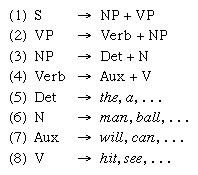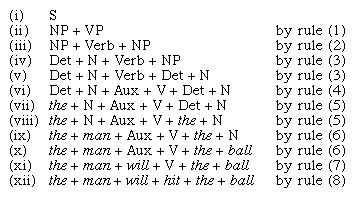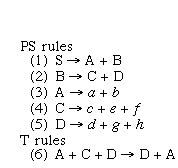



This is a simple phrase-structure grammar. It generates and thereby defines as grammatical such sentences as "The man will hit the ball," and it assigns to each sentence that it generates a structural description. The kind of structural description assigned by a phrase-structure grammar is, in fact, a constituent structure analysis of the sentence.
In these rules, the arrow can be interpreted as an instruction to rewrite (this is to be taken as a technical term) whatever symbol appears to the left of the arrow as the symbol or string of symbols that appears to the right of the arrow. For example, rule (2) rewrites the symbol VP as the string of symbols Verb + NP, and it thereby defines Verb + NP to be a construction of the type VP. Or, alternatively and equivalently, it says that constructions of the type VP may have as their immediate constituents constructions of the type Verb and NP (combined in that order). Rule (2) can be thought of as creating or being associated with the tree structure in Figure 3.
Rules (1)-(8) do not operate in isolation but constitute an integrated system. The symbol S (standing mnemonically for "sentence") is designated as the initial symbol. This information is not given in the rules (1)-(8), but it can be assumed either that it is given in a kind of protocol statement preceding the grammatical rules or that there is a universal convention according to which S is always the initial symbol. It is necessary to begin with a rule that has the initial symbol on the left. Thereafter any rule may be applied in any order until no further rule is applicable; in doing so, a derivation can be constructed of one of the sentences generated by the grammar. If the rules are applied in the following order: (1), (2), (3), (3), (4), (5), (5), (6), (6), (7), (8), then assuming that "the" is selected on both applications of (5), "man" on one application of (6), and "ball" on the other, "will" on the application of (7), and "hit" on the application of (8), the following derivation of the sentence "The man will hit the ball" will have been constructed:

Many other derivations of this sentence are possible, depending on the order in which the rules are applied. The important point is that all these different derivations are equivalent in that they can be reduced to the same tree diagram; namely, the one shown in Figure 4. If this is compared with the system of rules, it will be seen that each application of each rule creates or is associated with a portion (or subtree) of the tree. The tree diagram, or phrase marker, may now be considered as a structural description of the sentence "The man hit the ball." It is a description of the constituent structure, or phrase structure, of the sentence, and it is assigned by the rules that generate the sentence.
It is important to interpret the term generate in a static,
rather than a dynamic, sense. The statement that the grammar
generates a particular sentence means that the sentence is one
of the totality of sentences that the grammar defines to be
grammatical or well formed. All the sentences are generated,
as it were, simultaneously. The notion of generation must be
interpreted as would be a mathematical formula containing variables.
For example, in evaluating the formula y  + y for different values of y, one does not say
that the formula itself generates these various resultant values
(2, when y = 1; 5, when y = 2; etc.) one after another or at
different times; one says that the formula generates them all
simultaneously or, better still perhaps, timelessly. The situation
is similar for a generative grammar. Although one sentence rather
than another can be derived on some particular occasion by making
one choice rather than another at particular places in the grammar,
the grammar must be thought of as generating all sentences statically
or timelessly.
+ y for different values of y, one does not say
that the formula itself generates these various resultant values
(2, when y = 1; 5, when y = 2; etc.) one after another or at
different times; one says that the formula generates them all
simultaneously or, better still perhaps, timelessly. The situation
is similar for a generative grammar. Although one sentence rather
than another can be derived on some particular occasion by making
one choice rather than another at particular places in the grammar,
the grammar must be thought of as generating all sentences statically
or timelessly.
It has been noted that, whereas a phrase-structure grammar is one that consists entirely of phrase-structure rules, a transformational grammar (as formalized by Chomsky) includes both phrase-structure and transformational rules (as well as morphophonemic rules). The transformational rules depend upon the prior application of the phrase-structure rules and have the effect of converting, or transforming, one phrase marker into another. What is meant by this statement may be clarified first with reference to a purely abstract and very simple transformational grammar, in which the letters stand for constituents of a sentence (and S stands for "sentence"):

The first five rules are phrase-structure rules (PS rules); rule (6) is a transformational rule (T rule). The output of rules (1)-(5) is the terminal string a + b + c + e + f + d + g + h, which has associated with it the structural description indicated by the phrase marker shown in Figure 5 (left). Rule (6) applies to this terminal string of the PS rules and the associated phrase marker. It has the effect of deleting C (and the constituents of C) and permuting A and D (together with their constituents). The result is the string of symbols d + g + h + a + b, with the associated phrase marker shown in Figure 5 (right).
The phrase marker shown in Figure 5 (left) may be described as underlying, and the phrase marker shown in Figure 5 (right) as derived with respect to rule (6). One of the principal characteristics of a transformational rule is its transformation of an underlying phrase marker into a derived phrase marker in this way. Transformational rules, in contrast with phrase-structure rules, are also formally more heterogeneous and may have more than one symbol on the left-hand side of the arrow. The linguistic importance of these abstract considerations may be explained with reference to the relationship that holds in English between active and passive sentences.
Chomsky's rule for relating active and passive sentences (as given in Syntactic Structures) is very similar, at first sight, to Harris's, discussed above. Chomsky's rule is:

This rule, called the passive transformation, presupposes and depends upon the prior application of a set of phrase-structure rules. For simplicity, the passive transformation may first be considered in relation to the set of terminal strings generated by the phrase-structure rules (1)-(8) given earlier. The string "the + man + will + hit + the + ball" (with its associated phrase marker, as shown in Figure 4) can be treated not as an actual sentence but as the structure underlying both the active sentence "The man will hit the ball" and the corresponding passive "The ball will be hit by the man." The passive transformation is applicable under the condition that the underlying, or "input," string is analyzable in terms of its phrase structure as NP - Aux - V - NP (the use of subscript numerals to distinguish the two NPs in the formulation of the rule is an informal device for indicating the operation of permutation). In the phrase marker in Figure 4 "the" + "man" are constituents of NP, "will" is a constituent of Aux, "hit" is a constituent of V, and "the" + "ball" are constituents of NP. The whole string is therefore analyzable in the appropriate sense, and the passive transformation converts it into the string "the + ball + will + be + en + hit + by + the + man." A subsequent transformational rule will permute "en + hit" to yield "hit + en," and one of the morphophonemic rules will then convert "hit + en" to "hit" (as "ride + en" will be converted to "ridden"; "open + en" to "opened," and so on).
Every transformational rule has the effect of converting an underlying phrase marker into a derived phrase marker. The manner in which the transformational rules assign derived constituent structure to their input strings is one of the major theoretical problems in the formalization of transformational grammar. Here it can be assumed not only that "be + en" is attached to Aux and "by" to NP (as indicated by the plus signs in the rule as it has been formulated above) but also that the rest of the derived structure is as shown in Figure 6. The phrase marker in Figure 6 formalizes the fact, among others, that "the ball" is the subject of the passive sentence "The ball will be hit by the man," whereas "the man" is the subject of the corresponding active "The man will hit the ball" (cf. Figure 4).
Although the example above is a very simple one, and only a single transformational rule has been considered independently of other transformational rules in the same system, the passive transformation must operate, not only upon simple noun phrases like "the man" or "the ball," but upon noun phrases that contain adjectives ("the old man"), modifying phrases ("the man in the corner"), relative clauses ("the man who checked in last night"), and so forth. The incorporation, or embedding, of these other structures with the noun phrase will be brought about by the prior application of other transformational rules. It should also be clear that the phrase-structure rules require extension to allow for the various forms of the verb ("is hitting," "hit," "was hitting," "has hit," "has been hitting," etc.) and for the distinction of singular and plural.
It is important to note that, unlike Harris's, Chomsky's system of transformational grammar does not convert one sentence into another: the transformational rules operate upon the structures underlying sentences and not upon actual sentences. A further point is that even the simplest sentences (i.e.,kernel sentences) require the application of at least some transformational rules. Corresponding active and passive sentences, affirmative and negative sentences, declarative and interrogative sentences, and so on are formally related by deriving them from the same underlying terminal string of the phrase-structure component. The difference between kernel sentences and nonkernel sentences in Syntactic Structures (in Chomsky's later system the category of kernel sentences is not given formal recognition at all) resides in the fact that kernel sentences are generated without the application of any optional transformations. Nonkernel sentences require the application of both optional and obligatory transformations, and they differ one from another in that a different selection of optional transformations is made.